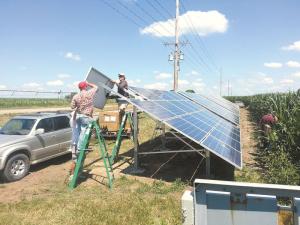Solar Power Cuts Irrigation Costs
 ✖  |
Setting up a solar array in an irrigated field is catching on as a way to reduce electric costs. Michael Shonka is putting in systems in Nebraska and surrounding states. He has worked with solar energy for 30 years and says there has never been a better time to go solar.
“Solar power has become much more cost effective in the past 10 years,” says Shonka. “The farmers putting these systems in don’t power the wellhead or the pivot directly. Instead, they produce energy all year round and then draw down earned credits when they start pumping water.”
Shonka points to the first solar system he put in an irrigated field. Although only a 25 kW system, it produced 40 kW hours in the first year, which was about 13 percent above what was expected.
“The past few years have been wetter than normal, and the typical farmer with solar has received a check at the end of the year,” says Shonka.
Shonka notes that irrigators using electric power for their rigs already have a power line in place so it’s easy to connect to the solar array. When siting panels, he places them at field edges to minimize the impact on production.
He expects demand to increase if commodity prices increase. At this point there are fewer farmers who can use a tax credit or depreciation. However, the cost of photovoltaic solar has never been better.
“Prices have come down considerably,” he says. “A 25 kW array cost $75,000 when it was put up a few years ago,” he recalls. “Today it would be $60,000 before tax credits or other incentives.”
He points out that current tax credits are good through 2018. They decrease by 5 percent each year after that and end in 2020.
“Those who bought early are still coming out ahead, even with the higher installation prices,” says Shonka.
Contact: FARM SHOW Followup, Solar Heat & Electric, 7342 Farnam St., Omaha, Neb. 68114 (ph 402 590-5900 or 402 850-7973; mshonka@qwest.net; www.solaromaha.com).

Click here to download page story appeared in.
Click here to read entire issue
Solar Power Cuts Irrigation Costs ENERGY Solar Setting up a solar array in an irrigated field is catching on as a way to reduce electric costs Michael Shonka is putting in systems in Nebraska and surrounding states He has worked with solar energy for 30 years and says there has never been a better time to go solar “Solar power has become much more cost effective in the past 10 years ” says Shonka “The farmers putting these systems in don’t power the wellhead or the pivot directly Instead they produce energy all year round and then draw down earned credits when they start pumping water ” Shonka points to the first solar system he put in an irrigated field Although only a 25 kW system it produced 40 kW hours in the first year which was about 13 percent above what was expected “The past few years have been wetter than normal and the typical farmer with solar has received a check at the end of the year ” says Shonka Shonka notes that irrigators using electric power for their rigs already have a power line in place so it’s easy to connect to the solar array When siting panels he places them at field edges to minimize the impact on production He expects demand to increase if commodity prices increase At this point there are fewer farmers who can use a tax credit or depreciation However the cost of photovoltaic solar has never been better “Prices have come down considerably ” he says “A 25 kW array cost $75 000 when it was put up a few years ago ” he recalls “Today it would be $60 000 before tax credits or other incentives ” He points out that current tax credits are good through 2018 They decrease by 5 percent each year after that and end in 2020 “Those who bought early are still coming out ahead even with the higher installation prices ” says Shonka Contact: FARM SHOW Followup Solar Heat & Electric 7342 Farnam St Omaha Neb 68114 ph 402 590-5900 or 402 850-7973; mshonka@qwest net; www solaromaha com
To read the rest of this story, download this issue below or click
here to register with your account number.







